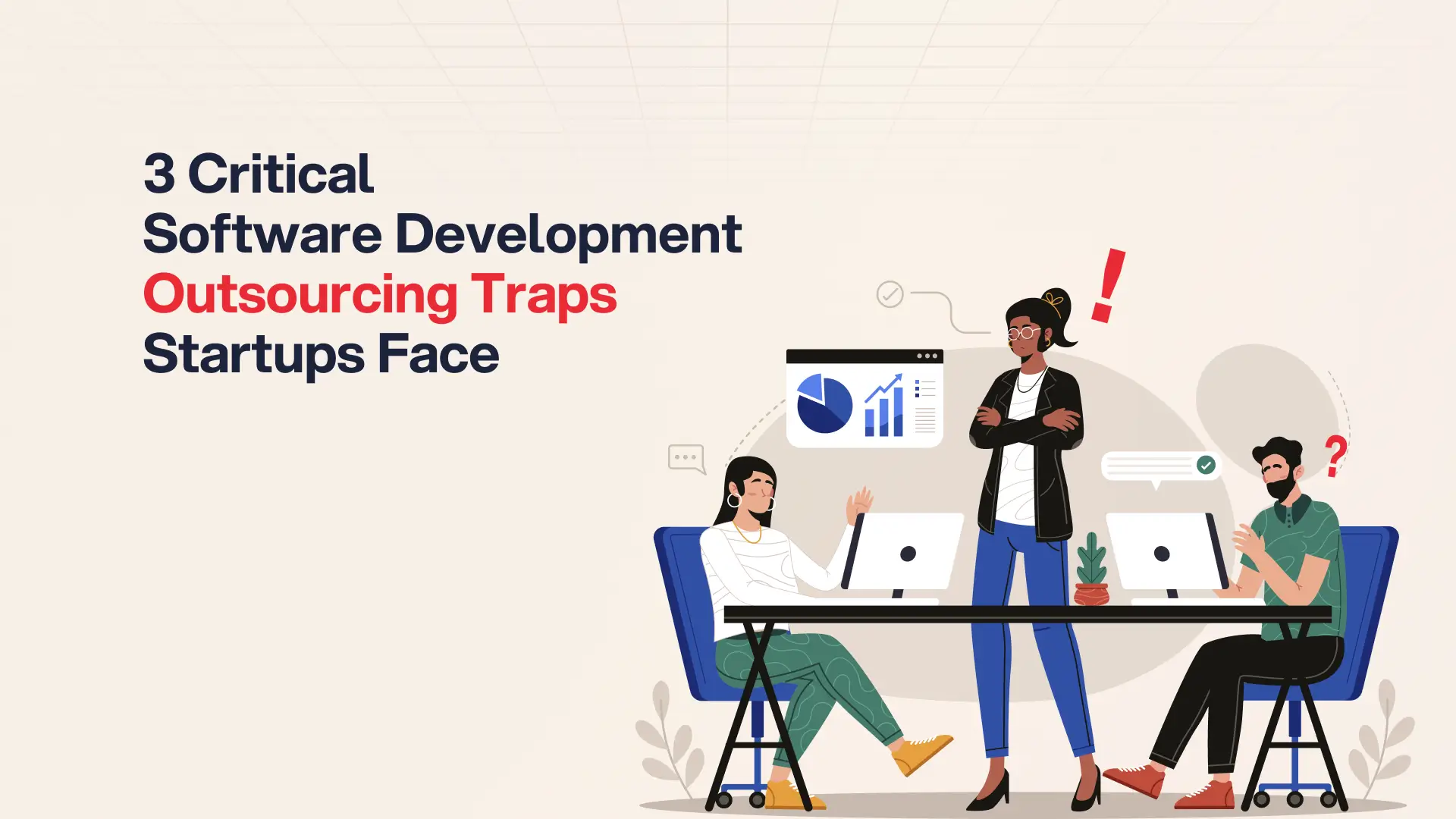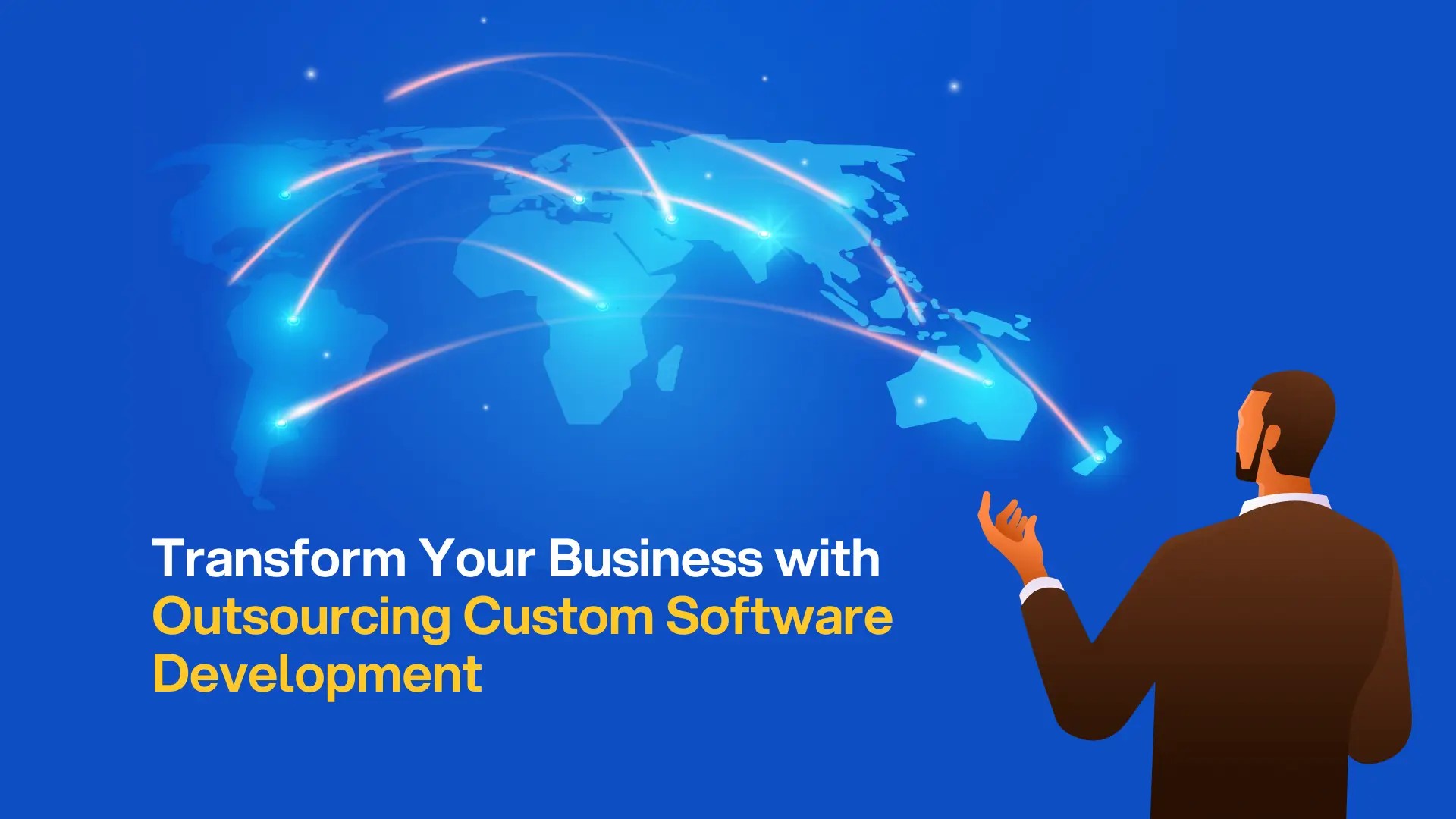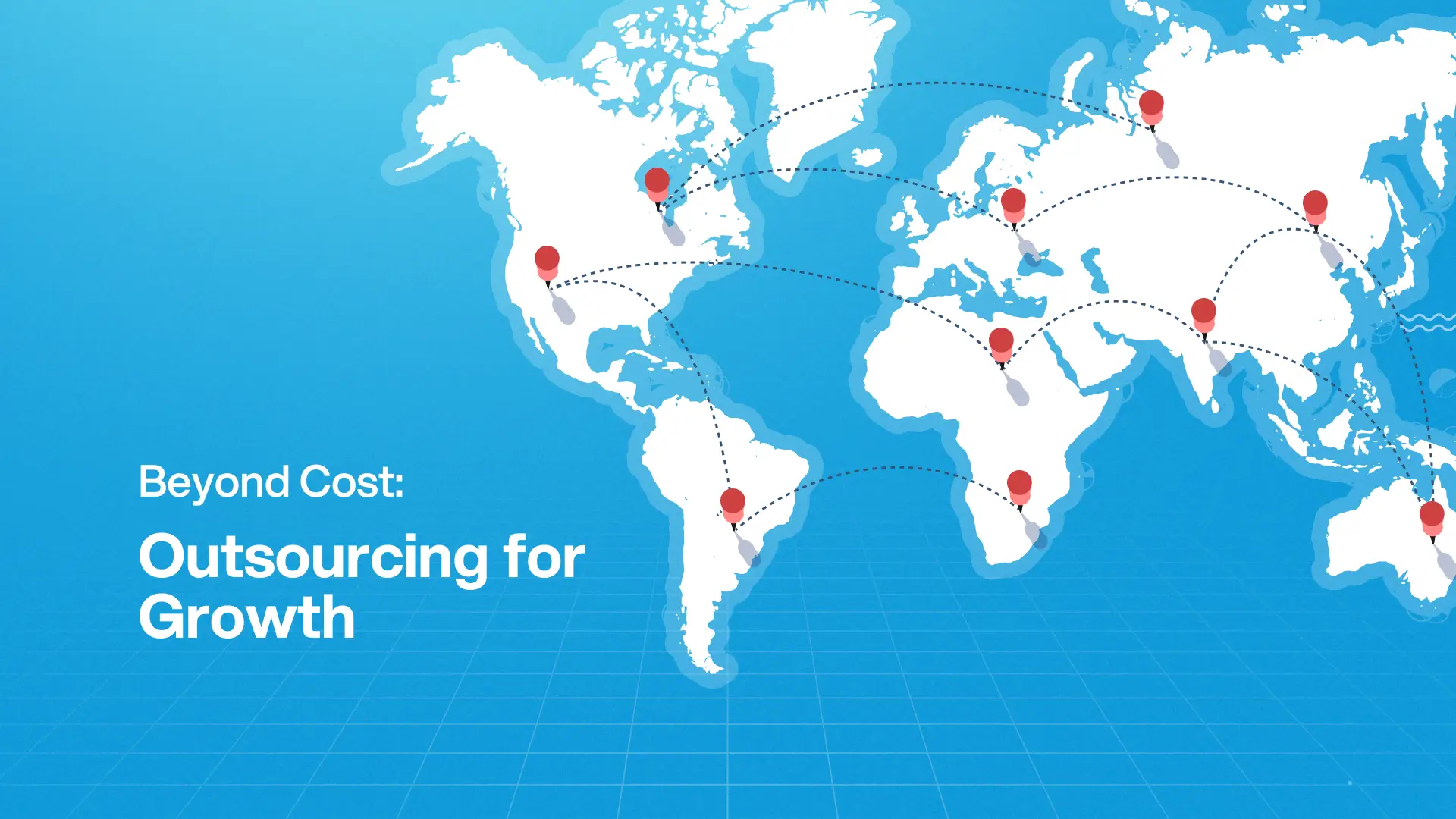Post Activity
 415
415
Table of Content
Share This Post
Table of Content
In 2025, IT outsourcing in India dominates with unmatched cost savings, a vast talent pool, and deep technical expertise. The country is supported by over 1,500 Global Capability Centers (GCCs) and agile delivery models. Its unique value lies in a large, English-speaking workforce, significantly lower labor costs, and a mature outsourcing ecosystem that enables high-quality services at scale.
Businesses benefit from 24/7 development cycles, proven process excellence, and the ability to ramp up quickly. As global demand for cost-effective, efficient, and flexible outsourcing rises, India remains the preferred destination for technology-driven partnerships.
Strategic Recap: Navigating India’s Outsourcing Trends
This recap frames India’s role as a hub for IT services and digital transformation.
i. Benefits
- Significant cost savings through competitive developer rates compared to Western markets.
- Deep and scalable technical talent pool across IT and engineering disciplines.
- Strong capabilities in cloud, AI/ML, and cybersecurity with enterprise-grade certifications.
- Seamless collaboration is enabled by high English proficiency and cultural alignment.
- Government support through tech incentives and liberalized investment policies.
ii. Challenges
- Intense competition for niche tech skills in major cities drives up hiring difficulty and costs.
- Rising developer salaries gradually reduce the cost advantage if not proactively managed.
- Inconsistent infrastructure in smaller cities can impact service reliability.
- Complex regulatory environment requires careful navigation of data, tax, and FDI laws.
- Intellectual property risks remain due to evolving enforcement and legal frameworks.
Country Overview
India’s strong economy, stable democracy with a political stability index of 21.33, and vast, English-proficient IT workforce of 17 million software engineers make it a leading IT outsourcing hub for 2025, outpacing regional competitors and Eastern European countries despite minor bureaucratic hurdles. With an inflation rate of 4.2% and a Foreign Exchange Rate of 86.4, India maintains a favorable business environment for cost optimization.
The economy of India at a glance
| Gross Domestic Product | ||
| Annual GDP | USD 3.57 Trillion (2023) | |
| GDP Per Capita | USD 2,481 (2023) | |
| Income Category | Lower-middle Income (2025) | |
| People | ||
| Population | 1.5 Billion (2025) | |
| Literacy Rate | 77% (2023) | |
| EF English Proficiency Index | Low Proficiency (2024) | |
| IT Sector | ||
| IT Services Market Size | USD 29.95 Billion (2025) | |
| IT Outsourcing Market Size | USD 12.7 Billion (2025) | |
| Registered Software Companies | 65,800+ (2025) | |
| Business Environment | ||
| Ease of Doing Business | Rank: 63 | Score: 71 (2020) | |
| Political Stability Indicator | Percentile Rank: 21.3 (2023) | |
| Corruption Perceptions Index | Score: 39/100 | Rank: 93/180 (2023) | |
The IT services market, valued at $39.83 billion, contributes $283 billion to GDP, driven by digital transformation initiatives.
Tech Ecosystem Overview
India’s IT outsourcing journey took off after the 1991 economic liberalization, which allowed pioneering firms like TCS and Infosys to capitalize on cost advantages and access global markets. Key milestones such as the Y2K crisis and the establishment of Software Technology Parks in 1991 accelerated industry growth. Since 2015, the government’s $13 billion Digital India initiative has driven the shift toward cloud computing, AI development, and widespread adoption of agile software methodologies. 80% of the industry has embraced agile methodologies for better operations.
By 2024, India’s IT software outsourcing sector will contribute 8% to the national GDP and employ 5.4 million technology professionals. Digital infrastructure continues to strengthen through initiatives like Digital India and Jio’s partnership with SpaceX to deploy Starlink internet. Meanwhile, India’s tech education pipeline remains strong, producing 2 million STEM graduates annually, with projections reaching 18 million by 2027. This powerful ecosystem supports India’s position as a global outsourcing leader.
Looking for IT Outsourcing Firms in India?
India’s tech ecosystem thrives in major hubs such as Bangalore, home to 1.5 million professionals and 26% of the country’s startups. Hyderabad follows with 800,000 tech workers, while Pune hosts 600,000 professionals with a strong focus on AI development. Gurgaon, an enterprise outsourcing hub, employs over 700,000. With more than 80,000 startups (including 110 unicorns valued at $350 billion), India attracted $10 billion in venture capital, earning the 22nd spot on the Startup Ecosystem Health Index.
A strong infrastructure in place supports this growth, including over 1,200 data centers, broadband access covering more than 65% of the population, and 5G connectivity available in 80% of urban areas. Prestigious institutions like the IITs, IIITs, and IISc, along with public-private initiatives such as the Skill India Digital Hub, continually elevate the country’s technical education.
However, data privacy remains a concern, as the evolving Digital Personal Data Protection Bill still lacks EU GDPR adequacy status.
Outsourcing Operations and Models
India offers flexible outsourcing models:
- Staff Augmentation: On-demand technical talent for flexible, cost-effective project scaling.
- Dedicated Teams: Long-term, self-managed teams tailored for consistent project delivery.
- Build Operate Transfer (BOT): Build and operate offshore operations, then transfer to client ownership.
- Hybrid: Agile workflows combining offshore delivery with flexible, scalable workflows.
- Global Capability Centers (GCCs): 1,500+ strategic hubs in India for innovation and cost savings.
- Agile Penetration: Over 85% of Indian vendors adopt agile delivery using Scrum or Kanban, ensuring iterative, enterprise-grade execution.
- ISO 27001 Certification: As per NASSCOM, 60%+ of outsourcing providers are ISO 27001 certified, reflecting strong alignment with global risk management frameworks.
Scaling Success with Tech Talent
Global Bank: $15 Million Savings on Cloud Migration
Cognizant, Bell Integration, HCL Technologies, and NTT Data collaborated to help a global bank modernize its legacy infrastructure by migrating core applications to a secure, scalable cloud environment. This resulted in $15 million in savings. Furthermore, Cognizant addressed complex legacy dependencies, enabling a smooth transition. On the other hand, Bell Integration ensured uninterrupted customer operations during the migration. Additionally, HCL Technologies lowered the bank’s total cost of ownership through streamlined systems. Meanwhile, NTT Data deployed a multi-cloud architecture for a major Indian bank, significantly enhancing its digital customer experience. Together, these providers demonstrated how strategic outsourcing partnerships can drive cost efficiency, resilience, and digital innovation in the financial sector.
Fintech Startup: 45% Faster MVP Deployment
Indian agile teams accelerated a fintech startup’s MVP deployment by 45%, leveraging cloud-native stacks and agile pods for rapid go-to-market, as highlighted by NASSCOM and EY’s global studies on fintech cloud and agile accelerations.
Retailer: 30% Shorter Engineering Cycles
A global retailer, supported by Indian engineering teams, reduced engineering cycles by 30% through agile and DevOps practices, mirroring the BCG Platinion’s case study on a bank’s cloud-driven transformation and NASSCOM’s reports on 20–30% cycle time reductions in retail.
Ready to Build Your Team?
Let’s create together, innovate together, and achieve excellence together. Your vision, our team – the perfect match awaits.
Strategic Advantages of Choosing India
Here’s why global businesses are turning to India for strategic growth and innovation.
Massive Talent Reservoir:
With over 17 million IT professionals, including software engineers skilled in programming languages and database systems, and 2 million+ STEM graduates annually (projected to reach 18 million by 2027), India offers a vast, skilled workforce ready to tackle complex tech projects from cloud computing to AI development.
Cost Arbitrage:
Achieve up to 70% cost savings compared to Western markets, with Indian developers charging $17–$50/hour versus $100–$150/hour in the US, driving unmatched ROI.
Technical Depth:
India leads in cloud computing, AI/ML, and cybersecurity, with 60%+ of outsourcing providers ISO 27001 certified, ensuring enterprise-grade solutions.
Cultural Alignment:
High English proficiency, a strong work ethic, and communication skills make Indian teams a natural fit for nearshore collaboration with the European Union, though time zone compatibility with the US requires tools like Google Meet.
Government Support:
The 2025 Union Budget allocates ₹20,000 crore for R&D centers and public-private tech programs, alongside FDI liberalization for tech parks, SEZs, and data centers, fostering a robust business environment.
Top IT Cities:
- Bengaluru: The Silicon Valley of India, anchoring innovation with 35% of the nation’s IT professionals, 500+ R&D centers, and $64 billion in IT exports.
- Hyderabad: Offers the best value for mid-sized firms, with cost-effective labor costs and cloud infrastructure, hosting 300+ GCCs.
- Pune: An AI/ML talent hotspot, with 150,000+ tech professionals and leading technical education institutes.
- Gurgaon: Provides proximity to global business centers, with a focus on BFSI and analytics, supported by modern digital infrastructure and connectivity.
India’s blend of talent, cost savings, and innovation makes it the go-to destination for outsourcing in 2025, delivering strategic value far beyond cost.
Limiting Factors When Working with India
The following challenges of IT outsourcing in India persist, but these are manageable:
- Talent Competition: With over 17 million IT professionals and more than 2 million STEM graduates annually, competition for niche skills (AI development, cybersecurity) in Tier-1 cities like Bengaluru is fierce, driving up labor costs and highlighting a talent shortage.
Mitigation: Leverage Tier-2/3 cities (e.g., Indore, Kochi) with around 1.5 million engineers at 20–30% lower costs and partner with universities for tailored training, as seen with TCS’s 100,000+ student programs. - Wage Inflation: Senior developer salaries in Tier-1 cities ($30–$50/hour in 2025) rise 10–15% yearly, slightly eroding the 70% cost advantage over Western markets ($100–$150/hour).
Mitigation: Secure long-term contracts with fixed rates and hire across cities like Chennai or Pune, where salaries are 15–25% lower, as practiced by HCL Technologies. - Infrastructure Gaps: Tier-2/3 cities may face inconsistent power or internet, risking project delays, though Tier-1 hubs like Hyderabad are robust.
Mitigation: Diversify operations across multiple locations and adopt cloud-first architectures (e.g., AWS, Azure), as Cognizant did for a bank’s $15M-saving cloud migration with 99.9% uptime. - Regulatory Complexity: The Digital Personal Data Protection (DPDP) Act 2023, tax regulations, and FDI compliance create hurdles; contract disputes can take 1–2 years to resolve due to legal bottlenecks.
Mitigation: Engage legal experts (e.g., EY, Deloitte) for DPDP and SEZ compliance, while partnering with vendors experienced in FDI setups for GCCs simplifies processes. - IP Risks: India’s evolving Intellectual Property regime, including the Copyright Act, faces risks of data breaches or weak enforcement in collaborative AI development/software engineering projects.
Mitigation: Enforce strict NDAs and partner with ISO 27001-certified vendors (60%+ of providers, per NASSCOM), using tools like blockchain for IP tracking, as Wipro does for 500+ global projects.
Vendor Selection Checklist
While IT outsorucing in India select vendors with:
- Industry-specific expertise (e.g., healthcare, fintech);
- Proven global delivery and international track records;
- Agile processes and robust IP security protocols;
- Scalability to handle growing project demands over time;
- Adequate team size to ensure resource depth;
- Positive client feedback and case studies demonstrating impact;
- Multi-time-zone support for seamless distributed team coordination;
- Transparent pricing models with clear cost breakdowns.
Final Thoughts
India leads the global IT outsourcing landscape with unmatched cost efficiencies, a massive pool of 17 million software engineers, and deep expertise in cloud solutions and AI development. While challenges like talent shortages and evolving legal frameworks persist, the rise of Tier-2 and Tier-3 tech hubs, robust cloud infrastructure, and a growing number of ISO 27001-certified firms ensure consistent, secure service delivery.
Flexible engagement models such as staff augmentation and the presence of over 1,500 R&D centers further enhance operational agility. Backed by a strong 21.33 Political Stability Index, IT outsourcing in India continues to offer a resilient, scalable, and innovation-driven outsourcing environment.
Find Your Perfect Software Outsourcing Partner
Unlock a world of trusted software outsourcing companies and elevate your business operations seamlessly.






